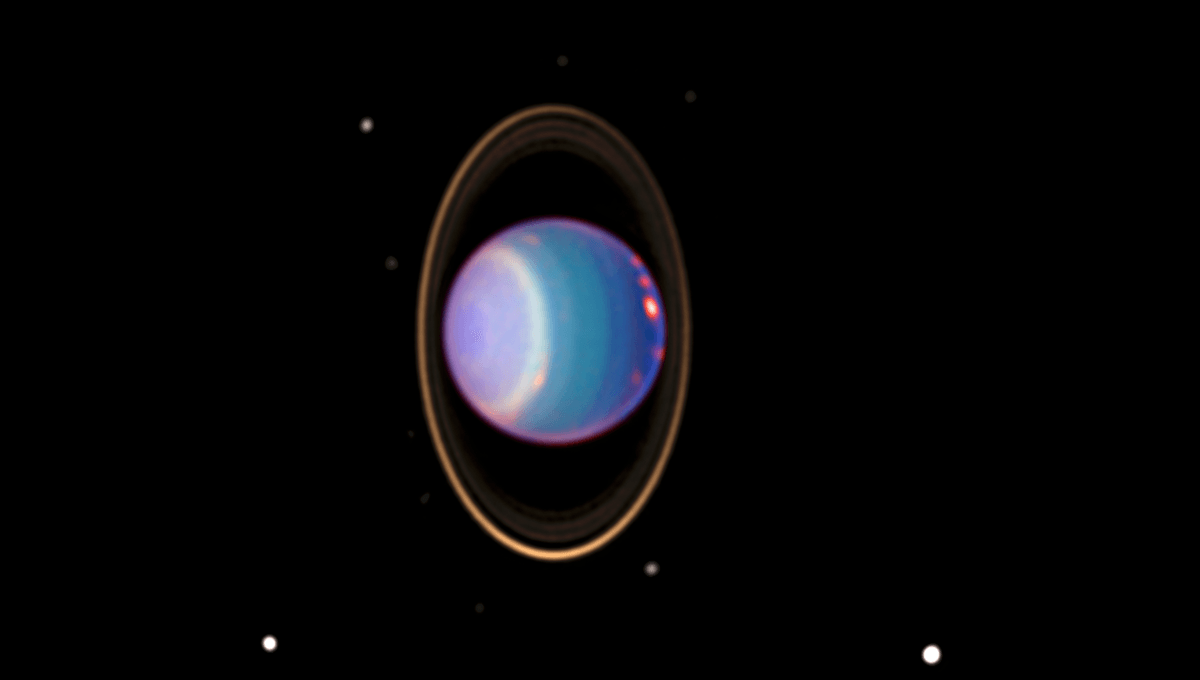
Two teams have separately concluded that Uranus is releasing more internal heat than was indicated in observations by Voyager 2. Instead of just reflecting heat from the Sun, it adds some of its own. The papers have yet to complete peer review, but in addition to the teams independently reaching similar conclusions, the findings bring Uranus more in line with its fellow gas giants.
ADVERTISEMENT
Planets have three sources of heat. There is the energy left over from the gravitational potential of their components, radioactivity, and the heat from the Sun. The first of these initially makes planets very hot, allowing us to see young planets many light-years away, but has largely dissipated after over 4 billion years. The balance between the other two depends on how radioactive the isotopes that compose the planet are and their distance from the Sun.
The Voyager missions revealed an apparent discrepancy between Uranus and the other three gas giants. Unlike the others, Uranus appeared to have no excess heat beyond its reflection of sunlight, suggesting minimal radioactive isotopes. Since Uranus and Neptune are so similar to each other in most ways, the difference was surprising, and comparisons with Jupiter and Saturn indicated it was Uranus that was the anomaly.
We haven’t been back to Uranus since, but telescopes on Earth and in orbit have advanced enough to allow a second look.
Professor Patrick Irwin of the University of Oxford and co-authors used observations made between 2000 and 2009 from the Hubble Space Telescope and Hawaii’s Gemini North and NASA Infrared Telescope Facility. They then sought to adjust for the fact Uranus was near its equinox at the time, instead of close to solstice when Voyager passed.
A team led by the University of Houston’s graduate student Xinyue Wang used observations beginning in the mid-20th century and added in those from more advanced instruments as they became available, extrapolating to an entire 84-year orbit.
Both teams conclude that either Voyager 2 mismeasured (an almost heretical thought) or it happened to go past Uranus at an unusual time, leading planetary scientists to the wrong conclusion. There’s been evidence that this may be the case regarding other features of the planet, so there might be something to it.
ADVERTISEMENT
Either way, “Uranus is not as odd as we thought it was,” Irwin told ScienceNews.
Both teams conclude Uranus reflects more heat into space than Voyager reported, implying an internal source. The teams differ slightly in terms of the amount of excess heat – 12.5 percent for one team, 15 percent for the other, but the margins of error overlap, so they’re effectively in agreement.
Both excess heat estimates are still far smaller than any of the other giant planets – Neptune produces so much internal heat it radiates more than twice as much as it receives, and the other two are close. “Uranus is still an outlier,” Irwin told ScienceNews,
The reasons for this remain unclear but may relate to the collision that is thought to have knocked Uranus on its side. Uranus’s extreme axial tilt increases the seasonal variation in how much heat it radiates, which is why Wang’s team chose to make estimates over an entire orbit.
ADVERTISEMENT
Wang and co-authors state: “The Uranus flagship mission, as recommended by the recent decadal survey, will provide crucial observations to address more unresolved questions and advance our understanding of this enigmatic ice giant,” but in the current environment for science in America, the chances of that occurring are doubtful. There will be a window to get a gravity boost from Jupiter, greatly cutting the cost and time of the mission, but that requires launching in 2032, so decisions are needed soon..
Preprints of the papers are available on arXiv.org here and here.
[H/T ScienceNews]
Source Link: Uranus Is Much Hotter Than We Thought